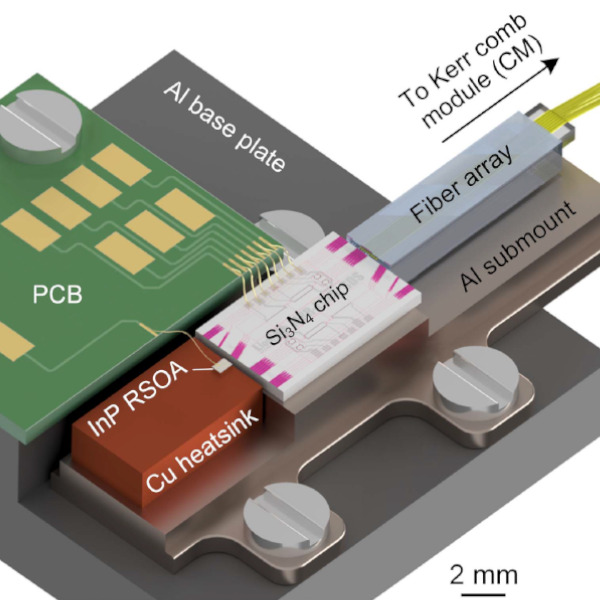Integrated Tunable Laser Generates Kerr Frequency Comb for the First Time
Hybrid photonic integration methods, where multiple photonic integrated circuits are connected to make up a single module, have proven to be reliable and robust approaches for novel applications. Our external cavity lasers are hybrid-integrated, and continue to prompt attention due to their compactness, broad tunability, and ultra-narrow intrinsic linewidths. With a new trick, their frequency precision has attained a new accolade: they are suitable for the generation of Kerr frequency combs!
A recent paper in Journal of Lightwave Technology, with research spearheaded by the Karlsruhe Institute of Technology, showcased the first single-soliton Kerr frequency comb generated with a hybrid-integrated tunable external cavity laser. External cavities integrated on silicon nitride have distinct advantages when compared to silicon photonics, such as high light power handling and no two-photon absorption. As silicon nitride does not generate light, the hybrid integration of gain and cavity chips also requires high placement precision. In this work, it was demonstrated that these alignment requirements can be alleviated via photonic wire bonds (PWB) and facet-attached microlenses while maintaining the module’s precise tunability and low optical losses.
How The Integrated External Cavity Lasers Works
The concept of this tunable continuous-wave laser is simple: an indium phosphide semiconductor optical amplifier (SOA) connected to our TriPleX® silicon nitride chip via a PWB. This approach sidesteps the technologically-intensive heterogenous integration approaches, while allowing the thermally-controlled feedback circuits on the silicon nitride chip to be insulated from the SOA’s heat byproducts. It also reduces the die placement accuracy of the total module.
A rendering of the external cavity laser module, with the gain and cavity photonic chips placed on an aluminum submount, connected to the control electronics and the comb module.
Typically, our external cavity lasers are edge-to-edge coupled, with our TriPleX® technology doing the heavy lifting of mode field size conversion from the gain chip to the Vernier filter and out to the output optical fiber. In this instance, the PWB were adapted to the different mode field sizes and waveguide positions of the gain and cavity chips, such that the optical losses were kept as low as 1.6 dB without waveguide cross section adaptation. The high-Q microresonators integrated on our platform produced an output light at 979 Hz linewidth with 59 dB side-mode suppression ratios, with 90 nm of tuning range (between 1480 nm and 1570 nm) and 12 dBm output powers, sufficient for a dissipative Kerr soliton frequency comb.
Kerr Frequency Combs Enabled by Hybrid Integration
The principal requirement from a pump laser for a Kerr soliton frequency comb is for it to follow a precise tuning profile. Our thermally-tuned external cavity laser fulfilled this requirement for the application, with particular advantages over the more conventional self-injection locking approach. This laser enables the independent control of the detuning of the pump tone from the cold ring resonance, which allows the frequency comb to be optimized to broad bandwidths or comb-line power.
Customization of our tunable lasers is always possible! Besides integration methods and the optical functions that can be added to the cavity circuit, the broad transparency window of silicon nitride allows for the waveguiding of any wavelength between 405 nm and 2350 nm.
Read more:
🌐 P. Maier et al., “Sub-kHz-Linewidth External-Cavity Laser (ECL) With Si3N4 Resonator Used as a Tunable Pump for a Kerr Frequency Comb,” in Journal of Lightwave Technology, vol. 41, no. 11, pp. 3479-3490, 1 June1, 2023, doi: 10.1109/JLT.2023.3243471.
🌐 Our ultra-narrow linewidth tunable lasers used in this work
🌐 Our TriPleX® silicon nitride waveguide technology used in this work



